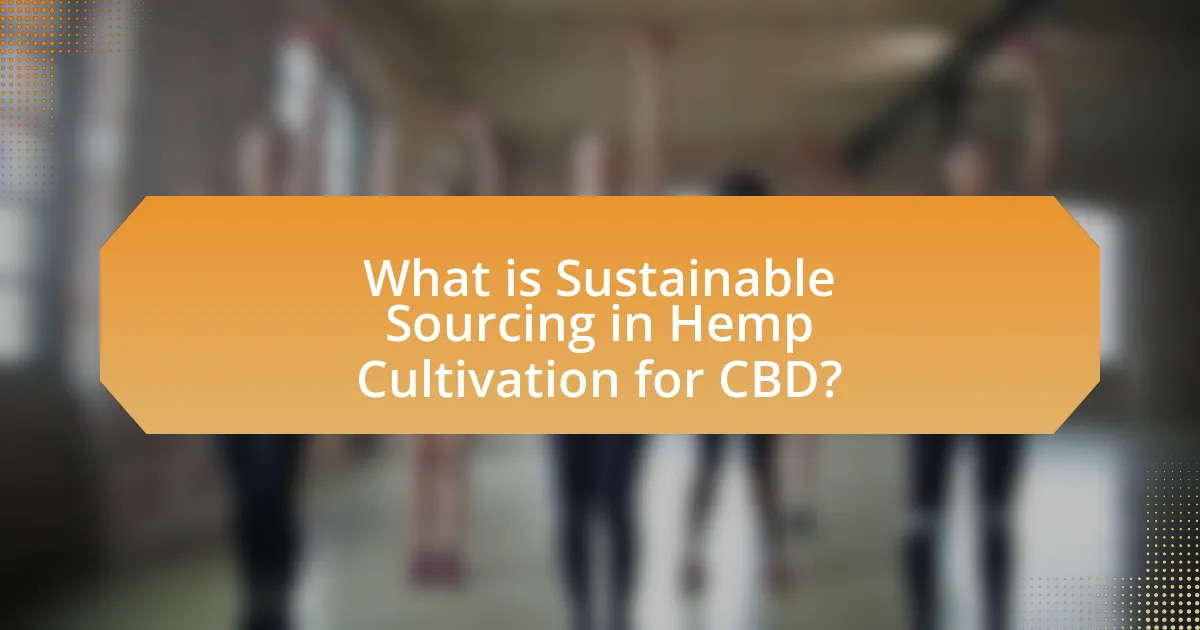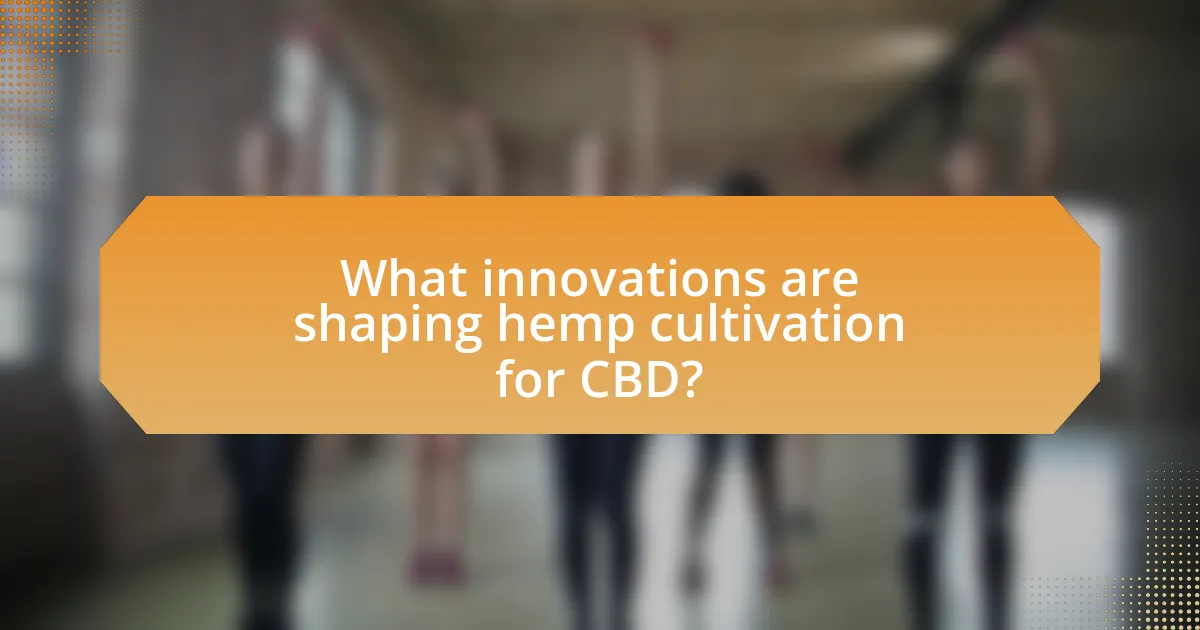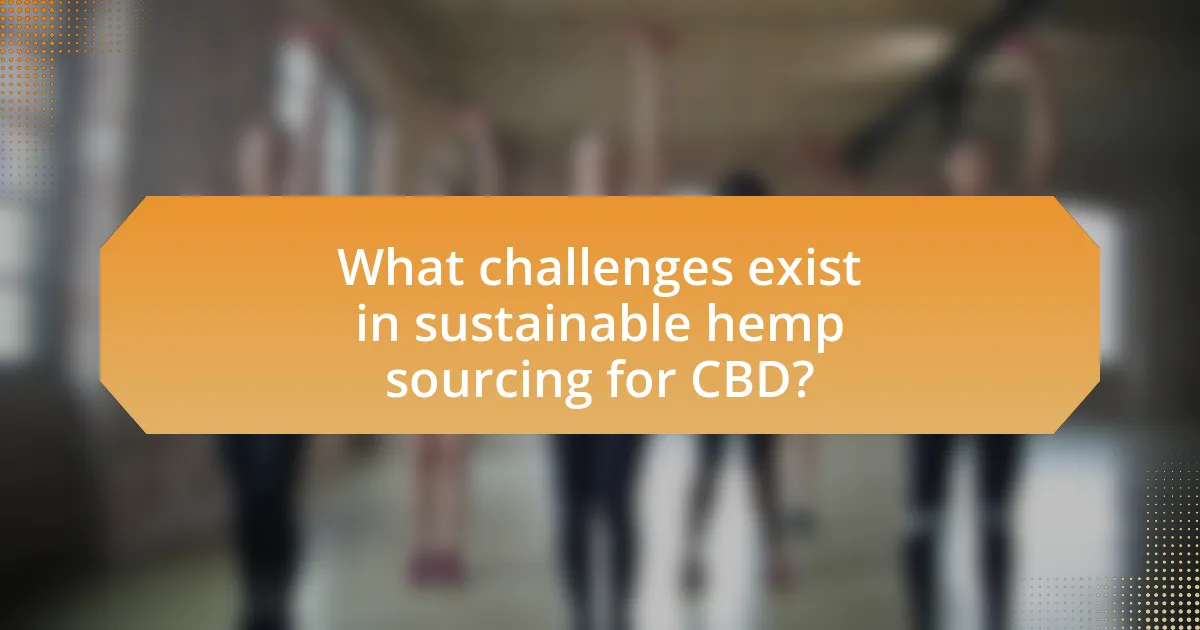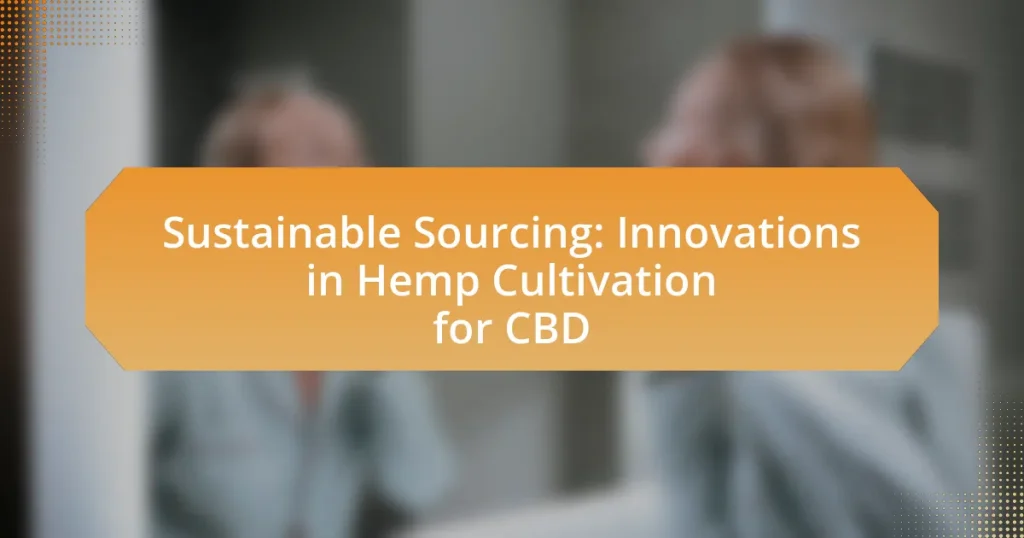Sustainable sourcing in hemp cultivation for CBD emphasizes environmentally responsible practices that minimize ecological impact while promoting social equity and economic sustainability. This article explores the principles of sustainable sourcing, including organic farming methods, reduced water usage, and fair labor practices, highlighting their benefits for soil health, biodiversity, and carbon sequestration. It also examines the innovations shaping hemp cultivation, such as precision agriculture and biotechnology, and addresses the challenges faced by farmers, including regulatory hurdles and market volatility. By adopting regenerative practices and fostering collaboration among stakeholders, the hemp industry can enhance its sustainability and meet the growing consumer demand for eco-friendly products.

What is Sustainable Sourcing in Hemp Cultivation for CBD?
Sustainable sourcing in hemp cultivation for CBD refers to the practice of obtaining hemp in a manner that minimizes environmental impact while promoting social responsibility and economic viability. This approach includes using organic farming methods, reducing water usage, and ensuring fair labor practices. For instance, sustainable hemp farming often employs crop rotation and natural pest control to maintain soil health and biodiversity, which can lead to higher quality CBD products. Additionally, according to a report by the Hemp Industries Association, sustainable practices can enhance the overall resilience of farming systems, making them more adaptable to climate change.
How does sustainable sourcing impact the hemp industry?
Sustainable sourcing significantly enhances the hemp industry by promoting environmentally friendly cultivation practices. This approach reduces the carbon footprint associated with hemp production, as sustainable methods often involve organic farming techniques that minimize chemical inputs and soil degradation. For instance, a study published in the Journal of Cleaner Production found that organic hemp farming can lead to a 30% reduction in greenhouse gas emissions compared to conventional methods. Additionally, sustainable sourcing fosters biodiversity and soil health, which are crucial for long-term agricultural viability. By prioritizing sustainable practices, the hemp industry can meet increasing consumer demand for eco-friendly products while ensuring compliance with regulatory standards aimed at environmental protection.
What are the key principles of sustainable sourcing?
The key principles of sustainable sourcing include environmental stewardship, social responsibility, and economic viability. Environmental stewardship focuses on minimizing ecological impact by using renewable resources and reducing waste, which is essential in hemp cultivation for CBD, as hemp is a low-impact crop that improves soil health. Social responsibility emphasizes fair labor practices and community engagement, ensuring that workers involved in hemp production are treated ethically and compensated fairly. Economic viability ensures that sourcing practices are financially sustainable for producers, allowing them to thrive while meeting consumer demand for responsibly sourced products. These principles collectively promote a holistic approach to sourcing that benefits the planet, society, and the economy.
How does sustainable sourcing differ from traditional sourcing methods?
Sustainable sourcing differs from traditional sourcing methods primarily in its focus on environmental and social responsibility. While traditional sourcing often prioritizes cost and efficiency, sustainable sourcing emphasizes the use of renewable resources, ethical labor practices, and minimal environmental impact. For instance, sustainable sourcing in hemp cultivation for CBD involves practices such as organic farming, which reduces chemical usage and promotes biodiversity, compared to conventional methods that may rely heavily on pesticides and synthetic fertilizers. This approach not only supports ecosystem health but also aligns with consumer demand for ethically produced products, as evidenced by a 2021 survey indicating that 73% of consumers prefer brands that are environmentally responsible.
Why is hemp considered a sustainable crop for CBD production?
Hemp is considered a sustainable crop for CBD production due to its low environmental impact and efficient growth characteristics. Hemp requires significantly less water than traditional crops, often thriving in poor soil conditions without the need for pesticides or herbicides, which reduces chemical runoff and soil degradation. Additionally, hemp has a rapid growth cycle, typically maturing in 90 to 120 days, allowing for multiple harvests in a single year. This fast growth contributes to carbon sequestration, as hemp absorbs carbon dioxide from the atmosphere during its growth. Studies indicate that hemp can produce more biomass per acre than most other crops, making it an efficient choice for sustainable agricultural practices.
What environmental benefits does hemp cultivation provide?
Hemp cultivation provides significant environmental benefits, including soil health improvement, carbon sequestration, and reduced pesticide use. The deep root system of hemp enhances soil structure and prevents erosion, while its rapid growth allows for substantial carbon dioxide absorption, contributing to climate change mitigation. Additionally, hemp requires fewer pesticides and herbicides compared to traditional crops, promoting biodiversity and reducing chemical runoff into ecosystems. Studies indicate that hemp can sequester up to 22 tons of carbon dioxide per hectare annually, underscoring its role in environmental sustainability.
How does hemp cultivation contribute to soil health?
Hemp cultivation contributes to soil health by enhancing soil structure, increasing organic matter, and promoting biodiversity. The deep root system of hemp improves soil aeration and water retention, which helps prevent erosion and compaction. Additionally, hemp plants contribute organic matter to the soil as they decompose, enriching nutrient levels. Research indicates that hemp can also suppress weeds and reduce the need for chemical herbicides, fostering a healthier ecosystem. Studies have shown that rotating hemp with other crops can lead to improved soil fertility and microbial activity, further validating its positive impact on soil health.

What innovations are shaping hemp cultivation for CBD?
Innovations shaping hemp cultivation for CBD include advanced breeding techniques, precision agriculture, and sustainable farming practices. Advanced breeding techniques, such as genetic modification and selective breeding, enhance cannabinoid profiles and yield, allowing for higher concentrations of CBD. Precision agriculture utilizes technology like drones and soil sensors to optimize resource use, improving crop health and reducing waste. Sustainable farming practices, including organic cultivation and crop rotation, promote soil health and biodiversity, ensuring long-term viability of hemp farming. These innovations collectively contribute to more efficient, environmentally friendly, and economically viable hemp cultivation for CBD production.
How are technological advancements improving hemp farming practices?
Technological advancements are improving hemp farming practices by enhancing efficiency, increasing yield, and optimizing resource management. Precision agriculture technologies, such as GPS-guided equipment and drones, allow farmers to monitor crop health and soil conditions in real-time, leading to more informed decision-making. For instance, a study published in the Journal of Agricultural Science found that the use of drones for crop monitoring can increase yields by up to 15% by enabling timely interventions. Additionally, advancements in genetic engineering have led to the development of hemp strains that are more resistant to pests and diseases, further improving productivity. Automated irrigation systems also contribute to water conservation and reduce labor costs, making hemp farming more sustainable and economically viable.
What role do precision agriculture techniques play in hemp cultivation?
Precision agriculture techniques significantly enhance hemp cultivation by optimizing resource use and improving crop yields. These techniques involve the use of technology such as GPS, sensors, and data analytics to monitor and manage field variability in crops. For instance, precision irrigation systems can reduce water usage by delivering the exact amount of moisture needed, which is crucial for hemp’s growth, as it requires specific water conditions. Additionally, soil sensors can provide real-time data on nutrient levels, allowing farmers to apply fertilizers more efficiently, thus minimizing environmental impact. Studies have shown that implementing precision agriculture can increase crop yields by up to 20% while reducing input costs, making it a vital component in sustainable hemp cultivation practices.
How can biotechnology enhance hemp crop yields?
Biotechnology can enhance hemp crop yields by utilizing genetic modification and advanced breeding techniques to develop strains with improved traits such as disease resistance, drought tolerance, and higher cannabinoid content. For instance, research has shown that genetically engineered hemp varieties can yield up to 30% more biomass compared to traditional strains, which is crucial for maximizing production efficiency. Additionally, biotechnological methods like CRISPR gene editing allow for precise modifications that can lead to faster growth rates and enhanced nutrient uptake, further contributing to increased yields.
What are the latest trends in sustainable hemp cultivation?
The latest trends in sustainable hemp cultivation include the adoption of regenerative agricultural practices, the use of precision farming technologies, and the integration of agroecological principles. Regenerative practices, such as cover cropping and crop rotation, enhance soil health and biodiversity, which are crucial for sustainable hemp production. Precision farming technologies, including soil sensors and data analytics, optimize resource use and minimize environmental impact. Additionally, agroecological principles promote the use of natural pest management and organic fertilizers, reducing reliance on synthetic chemicals. These trends are supported by research indicating that sustainable practices can increase yield and improve the ecological footprint of hemp cultivation.
How are farmers adopting regenerative agriculture practices?
Farmers are adopting regenerative agriculture practices by implementing techniques such as cover cropping, crop rotation, and reduced tillage. These methods enhance soil health, increase biodiversity, and improve water retention. For instance, a study published in the journal “Agriculture, Ecosystems & Environment” found that cover cropping can increase soil organic matter by up to 1.5% annually, which significantly boosts soil fertility and resilience. Additionally, farmers are utilizing integrated pest management and agroforestry systems to create more sustainable ecosystems, further supporting the regenerative agriculture movement.
What innovations are being made in pest management for hemp crops?
Innovations in pest management for hemp crops include the use of integrated pest management (IPM) strategies, biopesticides, and precision agriculture technologies. IPM combines biological control, habitat manipulation, and resistant varieties to minimize pest impact while reducing chemical inputs. Biopesticides derived from natural materials, such as plants and microorganisms, are being developed to target specific pests without harming beneficial insects. Precision agriculture technologies, including drones and sensors, enable farmers to monitor pest populations and crop health in real-time, allowing for targeted interventions. These advancements are supported by research indicating that IPM can reduce pesticide use by up to 50%, enhancing sustainability in hemp cultivation.

What challenges exist in sustainable hemp sourcing for CBD?
Sustainable hemp sourcing for CBD faces several challenges, including regulatory inconsistencies, environmental impacts, and market volatility. Regulatory inconsistencies arise from varying state and federal laws regarding hemp cultivation, which complicates compliance for farmers and producers. Environmental impacts include soil degradation and water usage, as intensive farming practices can lead to resource depletion. Market volatility is driven by fluctuating demand and prices for CBD products, making it difficult for growers to maintain stable operations. These challenges hinder the development of a reliable and sustainable hemp supply chain for CBD.
What regulatory hurdles do hemp farmers face?
Hemp farmers face significant regulatory hurdles primarily related to compliance with federal and state laws governing hemp cultivation. The 2018 Farm Bill legalized hemp at the federal level, but it also established strict regulations, including a THC limit of 0.3% on a dry weight basis, which farmers must adhere to in order to avoid penalties. Additionally, many states have their own regulations that can vary widely, creating a complex legal landscape that farmers must navigate. For instance, some states require licenses for cultivation, while others impose specific testing and reporting requirements. These regulatory inconsistencies can hinder farmers’ ability to operate efficiently and can lead to increased costs and legal risks.
How do varying state laws impact hemp cultivation?
Varying state laws significantly impact hemp cultivation by establishing different regulations regarding licensing, cultivation practices, and THC content limits. For instance, some states require extensive permits and testing, while others have more lenient regulations, affecting the ease of entry for farmers. According to the 2018 Farm Bill, states can create their own hemp programs, leading to a patchwork of laws that can either facilitate or hinder cultivation efforts. This inconsistency can create challenges for farmers who wish to operate across state lines, as they must navigate differing legal frameworks and compliance requirements.
What are the challenges in obtaining organic certification for hemp?
Obtaining organic certification for hemp presents several challenges, primarily due to regulatory complexities and stringent compliance requirements. The USDA’s National Organic Program mandates that hemp must be grown without synthetic fertilizers or pesticides, which can be difficult for farmers transitioning from conventional practices. Additionally, the lack of established organic standards specifically for hemp creates ambiguity in the certification process, leading to potential delays and increased costs. Furthermore, the presence of THC in hemp complicates certification, as any crop exceeding 0.3% THC is considered non-compliant, necessitating rigorous testing and monitoring. These factors collectively hinder the ability of hemp producers to achieve and maintain organic certification.
How can farmers overcome obstacles in sustainable hemp sourcing?
Farmers can overcome obstacles in sustainable hemp sourcing by implementing regenerative agricultural practices, which enhance soil health and biodiversity. These practices include crop rotation, cover cropping, and reduced tillage, which not only improve the sustainability of hemp cultivation but also increase resilience against pests and diseases. Research indicates that regenerative practices can lead to a 20-40% increase in soil organic matter, thereby improving water retention and nutrient availability, essential for hemp growth. Additionally, farmers can collaborate with local organizations and participate in certification programs that promote sustainable practices, ensuring compliance with environmental standards and enhancing market access.
What best practices can be implemented for successful hemp cultivation?
Successful hemp cultivation can be achieved by implementing best practices such as selecting high-quality seeds, ensuring optimal soil conditions, and utilizing sustainable pest management techniques. High-quality seeds are crucial as they determine the plant’s growth potential and cannabinoid yield. Optimal soil conditions, including proper pH levels (between 6.0 and 7.0) and nutrient availability, promote healthy plant development. Sustainable pest management techniques, such as integrated pest management (IPM), reduce chemical usage and enhance biodiversity, leading to healthier crops. These practices are supported by research indicating that proper seed selection and soil management significantly increase yield and quality in hemp production.
How can collaboration among stakeholders enhance sustainable sourcing?
Collaboration among stakeholders enhances sustainable sourcing by fostering shared knowledge, resources, and best practices that lead to more efficient and environmentally friendly supply chains. When farmers, manufacturers, retailers, and consumers work together, they can establish common sustainability goals, such as reducing carbon footprints and minimizing waste. For instance, a study by the World Economic Forum highlights that collaborative initiatives can lead to a 30% reduction in resource use through shared technology and practices. This collective approach not only improves the sustainability of hemp cultivation for CBD but also strengthens market resilience and consumer trust.
What practical tips can be applied to improve sustainable sourcing in hemp cultivation?
To improve sustainable sourcing in hemp cultivation, farmers should implement crop rotation, utilize organic fertilizers, and adopt water-efficient irrigation practices. Crop rotation enhances soil health and reduces pest infestations, leading to higher yields and lower chemical usage. Organic fertilizers, such as compost or manure, enrich the soil without harmful synthetic chemicals, promoting a healthier ecosystem. Water-efficient irrigation methods, like drip irrigation, minimize water waste and ensure that hemp plants receive adequate moisture, which is crucial for optimal growth. These practices collectively contribute to a more sustainable and environmentally friendly approach to hemp cultivation.



